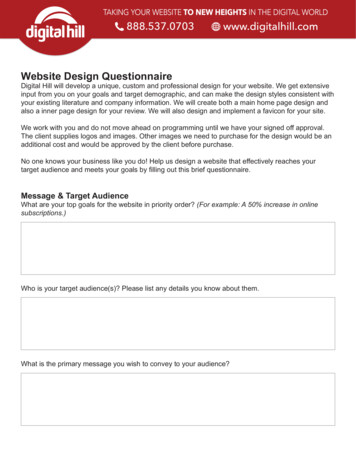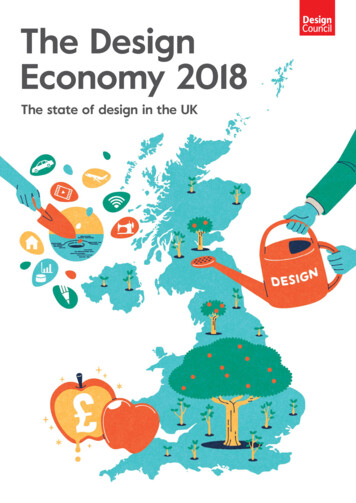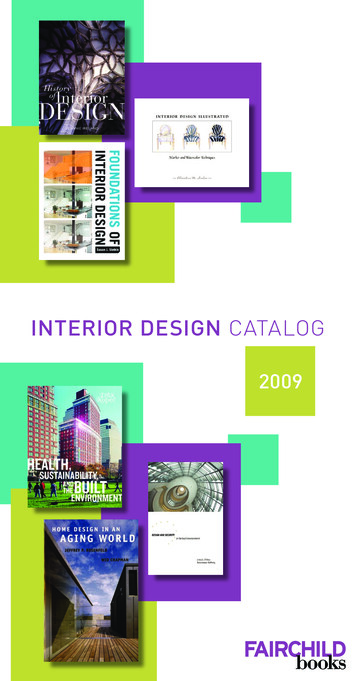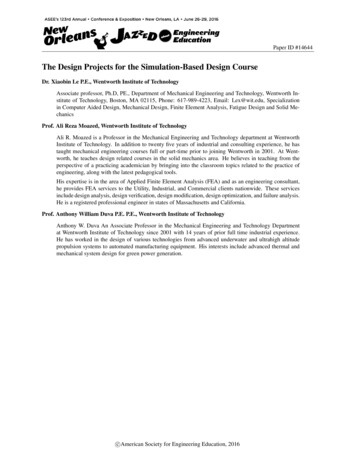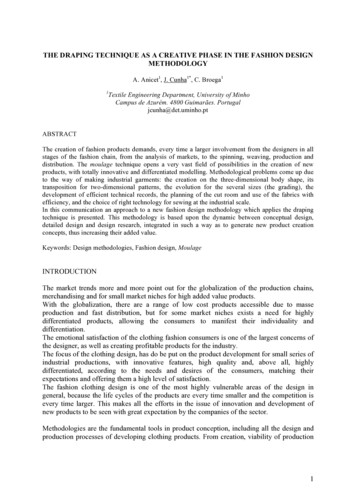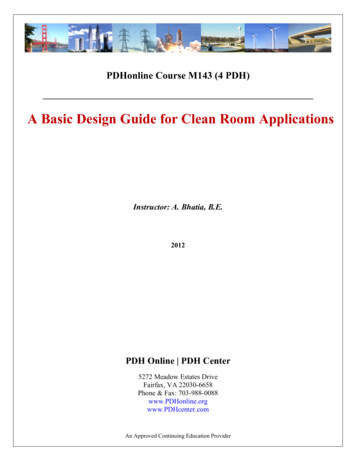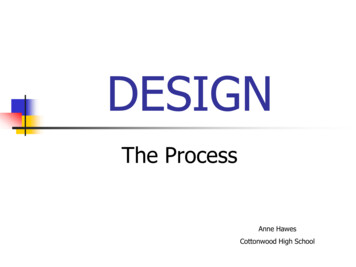
Transcription
DESIGNThe ProcessAnne HawesCottonwood High School
Design is: The process of selecting andorganizing materials to fulfill afunction.It is a conscious not instinctiveprocess.
Factors That Influence Design: Function what purpose will the objectserve?Materials of what will the object bemade?Technology how will the object bemade?Style Is the object appropriate andappealing to the user?
Function Purest form is creating something thathas never existed.Most design today is, in reality,redesign or improving designs.Each change in a design should bringabout improvement.―FORM FOLLOWS FUNCTION‖
Telephone Design Evolution:
Evolution ofCell Phone Design
Materials: Be open minded butpractical.Don’t avoid newmaterials.Select materials that aresuitable and able to fulfillthe intended use.
Technology Before industrialrevolution everythingwas made be handwhich limited whatcould be produced.Today we decide whatwe want then constructthe machine to producedesired product.
Style Difficult to separate style from materials.Differ from one period to another, evenfrom one home to another.Our lifestyles determine the style ofinterior design we use.Today’s styles are an accumulation ofpast styles but include new materials andtechnologies.
Types of Design Structural Decorative
STRUCTURAL DESIGN STRUCTURAL DESIGN is the integralpart of the structure itself—when thestructure and design cannot beseparated.Good proportion and safety areimportant to structural design.
STRUCTURAL DESIGN
STRUCTURAL DESIGN
STRUCTURAL DESIGN
STRUCTURAL DESIGN
STRUCTURAL DESIGN
STRUCTURAL DESIGN
Activity: Pick out an object in the room.Determine its FUNCTION.How does its FORM FOLLOW ITSFUNCTION.Describe its STRUCTURAL DESIGN.
DECORATIVE DESIGN DECORATIVE DESIGN involves theapplication of color, line, texture, orpattern to an object.DECORATIVE DESIGN may be used toenhance a structural design or may besimply a work of art.
DECORATIVE DESIGN
SUCCESSFUL DECORATIVEDESIGN: Must be suitablefor the intendeduse of the item.Must not obstructits use orfunction.
SUCCESSFUL DECORATIVEDESIGN: Should be appropriatefor the materials fromwhich the article ismade.Should accent the shapeand form of the object.Should not make theobject difficult to use.Materials shouldcoordinate withintended use of theobject.
SUCCESSFUL DECORATIVEDESIGN: Embellishmentshould be used toemphasizestructural points.This can actually aidin the correct use ofthe object by callingattention to edges,handles, etc.
SUCCESSFUL DECORATIVEDESIGN: Decorationshould beappropriatein size andamount tothe object.
TYPES OF DECORATIVEDESIGN: NATURALISTIC – reproductions ofnatural subjects.
TYPES OF DECORATIVEDESIGN: STYLIZED – arepresentationthat simplifiesthe subject toemphasize thebasic qualities.
TYPES OF DECORATIVEDESIGN: ABSTRACT – unrecognizable as aspecific object or thing.
TYPES OF DECORATIVEDESIGN: GEOMETIC – design made with the useof stripes, plaids and/or geometricshapes.
Applying What You LearnedIdentify the type of decorativedesign of this slide background.1. Is it suitable for intended use and does it obstruct use or function?2. Is it appropriate for the materials and does it coordinate with theintended use?3. Does it accent the shape and form of the object?4. Does it emphasize structural points and call attention to details?5. Is it appropriate in size and amount to object?
Designing Business Cards On paper experiment with the fourdifferent type of decorative designs tocreate a design for a personal businesscard.Select two of the designs to use.On a 5‖ x 8‖ index card create 2business card shapes, each 2‖ x 3‖.Space them evenly on the index card.
Designing Business Cards (cont.) On each of the cardsrecreate your design inan appropriate size andposition.Use colored pencils toadd color if desired.Leave space for yourpersonal information.Use Professionallettering for your nameand contact information.
ASSIGNMENT: Structural andDecorative Design1. Using magazines to find large, clearpictures illustrating the followingexamples of design:a. Structural/Decorative building designb. Structural/Decorative room designc. Structural/Decorative furniture design2. Identify the types of decorative designused in each picture.
ASSIGNMENT: Structural andDecorative Design1. Mount each picture on ONE side of a sheetof black paper.2. Using professional lettering discussed andpracticed in class, label each picture withthe appropriate title.3. Place pictures in the correct order, as listed.4. Design a section divider for your notebookthat includes the title DESIGN PROCESS,your name, date and period.5. Neatness and presentation are important.
Decorative Design 1. Using magazines to find large, clear pictures illustrating the following examples of design: a. Structural/Decorative building design b. Structural/Decorative room design c. Structural/Decor



